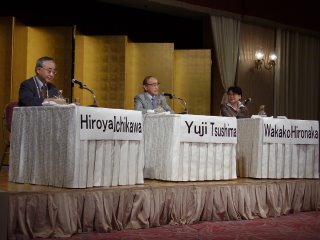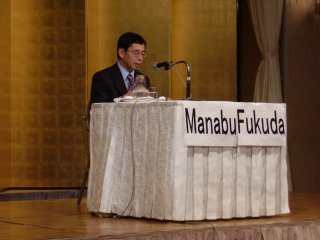

We arrived in Kesennuma this evening and I immediately tried out their LAN connection. It works like a charm! I'm very happy that I'll be able to give an update on the things I have learned so far.
So, here's some information on the seminars I have attended.
The Government of Japan:
The Japanese governmental system is based on ideas from the United States and German systems of government. There are two houses that comprise the National Diet: the House of Representatives and the House of Councillors. Representatives' terms are four years in length, but can end earlier than that if the House is dissolved (like the British and German parliamentary systems). The Councillors' terms are for six years and dissolution is not possible. Both Houses have a mix of proportional representation and either single-seat constituency (Representatives) or plural-seat prefectural constituency (Councillors).
The Prime Minister is picked from the Members of the Diet that hold majority control. This type of system, where the executive branch of government is dependent on the legislative branch to exist is called a parliamentary cabinet system.
Japan has a multi-party system, however one party – the LDP - has mainly held power. Mr. Tsushima, one of the panel members, is a very powerful man within this party. His position is equivalent to being in charge of the House Ways and Means Committee in the United States (and I saw him on a political poster in Kyoto). Mrs. Hironaka, the other panel member, was a representative of the opposition party, DPJ.
Both speakers talked about the worries they have regarding the pension system since the Japanese people live longer than any others, and the birthrate (the average number of times a woman gives birth during her lifetime) in Japan is only 1.25 (2005) and has been steadily declining faster than predicted. So, the pension problem is even bigger than in the United States, where the birth rate is (in comparison) a robust 2.13.
Japan’s unemployment rate is only 5.4% - which seems comparable to the U.S. However, Japan has a tradition of “lifetime employment” and the unemployment rate used to be 1-2%.
The Economy of Japan:
Economy Facts
• 128 million people live in Japan, with 31 million of them live in the Tokyo Metropolitan Area.
• There are only eight million foreigners registered – with most of them from other Asian countries.
• There are 49, 000 registered U.S. Citizens in Japan. It is a VERY homogenous society.
• In 2002, Japan had the second highest GDP in the world (but it’s still a little less than half that of the United States).
• Almost 77% of Japanese work in the service industry. Manufacturing makes up a little over 20% and agriculture is only 1.5% of the economy.
• The average national income in Japan is $24,700 vs. $33,200 in the United States. The Japanese Government invests in the United States (specifically 22% of their investments are there).
• There were 870,000 cell phones in use in 1990; in 2002 there were 81 million!
• Farming, specifically rice production has been going on in Japan since 4000 BC.

1 Comments:
Mrs. Banas, okay, so it's taken me about 40 minutes to read all you have wrote about your incredible Japan trip. Seeing as how you should be arriving home in Buffalo tomorrow I guess, I hope you had an amazing time and I loved all of your pictures!! The scenery is so beautiful and calming and I can't begin to imagine how wonderful of an experience this must have been.
See you next year, Enjoli!
Post a Comment
<< Home